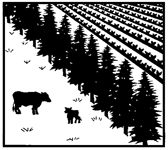United States Department of Agriculture, Forest Service, National Agroforestry Center

Agroforestry Notes (USDA-NAC)
Date of this Version
July 1992
Document Type
Newsletter Issue
Citation
National Agroforestry Center, United States Department of Agriculture, Forest Service, Rocky Mountain Station, United States Department of Agriculture, Natural Resources Conservation Service, Lincoln, Nebraska
Abstract
For the past 3,000 years or more the roots of a perennial plant called ginseng have been an important component of traditional Chinese medicine. The roots of wild American ginseng have been harvested, dried, and exported from the United States and Canada to China, since the mid 1700’s. Today, American ginseng is also a very important part of traditional Chinese medicine. It is used as an “adaptogen” that allows the body to adjust to various types of stress. It is not used as a specific cure or remedy for any particular ailment but as a component of many medicinal herbal combinations that help people deal with the aging process and related disorders.
Presently there are dozens of over-the-counter herbal remedies, available in local drug stores, which contain ginseng or ginseng extracts. Ginseng has become one of the most popular herbs of the 1990’s as Americans and Europeans seek alternatives to prescription drugs. Unfortunately many of the ginseng products available in local stores do not contain any American ginseng. Usually they contain extracts of either Asian ginseng, which is widely cultivated in China and Korea, or so-called “Siberian ginseng” which is a related plant, but not a true species of ginseng. According to the U.S. Department of Commerce, as long ago as 1858 the U.S. exported more then 350,000 pounds of dried wild ginseng roots. American ginseng has been cultivated in the U.S. since the late 1800’s, primarily in the northeast, southeast and the midwest.


Comments
United States government work